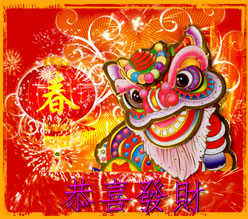
Chinese New Year:
History & Overview
From Bangkok to New York's Chinatown, the Chinese New Year is the pinnacle celebration for billions of Chinese people around the world. The holiday begins on the New Moon on the first day of the Chinese New Year and continues for 15 days, through the end of the full moon. More than any other Chinese holiday, the New Year stresses the importance of familial ties.
The biggest celebration during the two-week period is on the eve of the holiday. Much like New Year's Eve in the West, the Chinese celebrate their New Year with elaborate parties and fireworks displays. A lavish communal feast is held, featuring plentiful dishes of pig, duck and sweet pastries. A special place is set at the family table to honor the presence of ancestors. Their spirits, together with those still living, celebrate the New Year together as one community.
The New Year's evening is capped off with grand fireworks displays in most metropolitan areas. Early the next morning, youngsters receive Hong Bao -- a red envelope filled with money -- from their parents. The color red is traditionally associated with luck and good fortune in the Chinese culture. In addition to the celebratory aspects of the holiday, the New Year is also a time for forgiving past hurts and reconciling with estranged friends or family members.
There are other significant holidays during the New Year period, including the Jie Cai Ceng, or Welcoming the Gods of Wealth and Prosperity. This special celebration falls on the fifth day of the New Year. Many people take vacation from the first through the fifth days and return to work after the conclusion of the Jie Cai Ceng. The last day of the 15-day Chinese New Year celebration is known as Yuan Xiao Jie, or the Lantern Festival, which is marked by parades and parties -- and ubiquitous displays of lanterns.
The origin of the Chinese New Year can be traced by to ancient legend about a mythical beast known as Nien. This large-mouthed beast would attack villages in the dead of winter, devouring animals, crops and even children in a single bite. Villagers would flee to the mountains every year, to hide from the Nien One year, an old man -- or, in some versions of the legend, an old woman -- refused to run and hid. He stayed behind and prepared for the beast's arrival. When Nien came to his home, the old man set of loud, red firecrackers, scaring away the beast for good.
From then on, Chinese families hung red banners and set of fire crackers -- now fireworks -- to keep the Nien away. Interestingly, the Chinese word for 'year' is Nian, and these traditional defense strategies came to be known as the Passing of Nian.
setTemplate('chineseny'); print $articles; ?>

